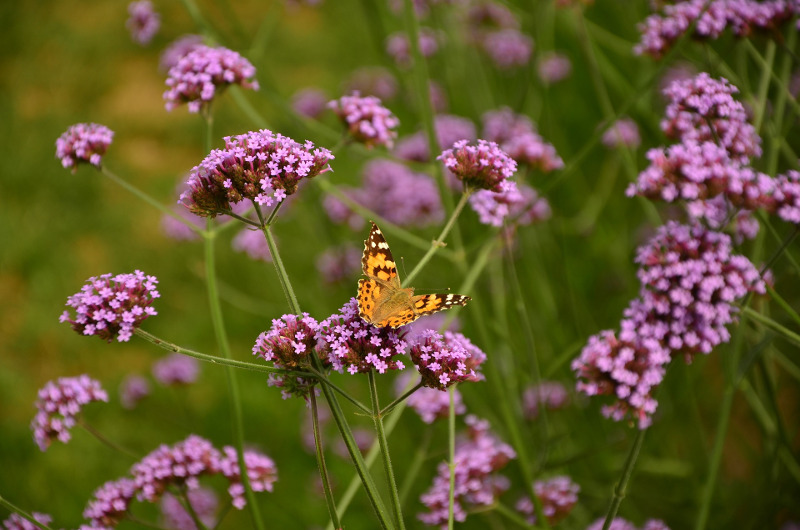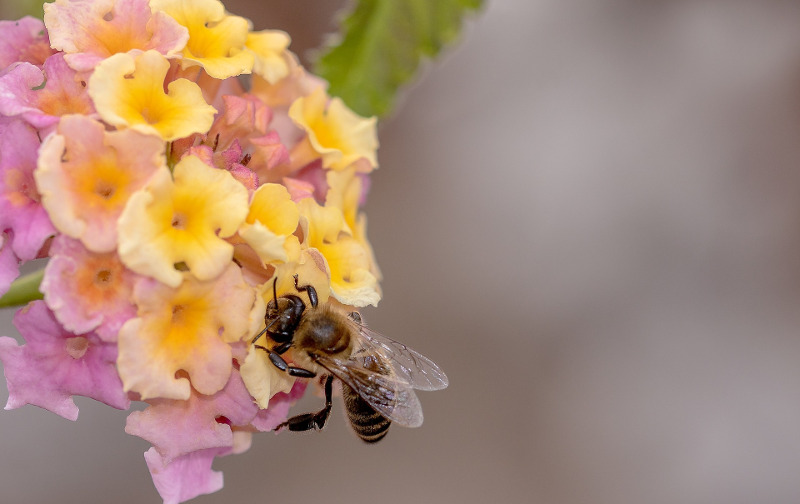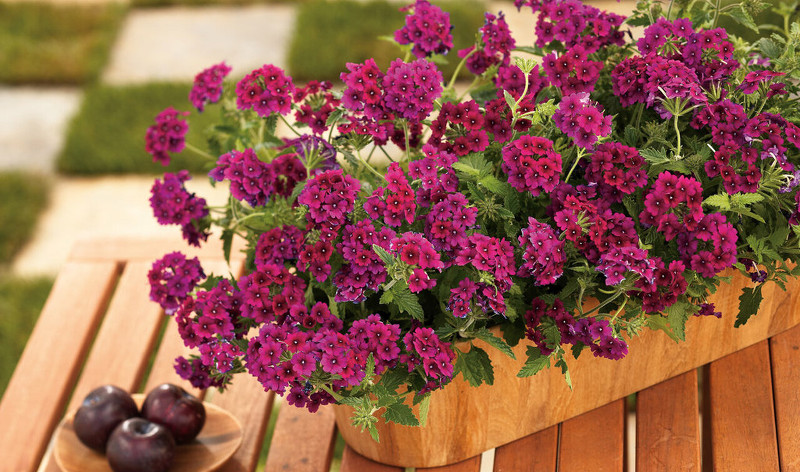Verbena (Verbena x) is a genus in the family Verbenaceae. It contains about 150 species of annual and perennial herbaceous or semi-woody flowering plants. The majority of the species are native to the Americas and Asia. Depending on the variety, this plant grows up to 12 inches tall with an 18 spread.
Flowers appear all summer in circular clusters, for a delicate look up close but for colorful attention from afar. Verbena blooms range in color from white, red, pink, lavender, blue or purple.
Growing in USDA zones 8-10, this plant likes partial to full sun. Gardeners use Verbena for groundcover, landscaping beds or as a spiller in a container.

Planting Verbena
Plant Verbena in the spring when the threat of frost has passed. Choose an area that will get 8-10 hours of full sun each day. Too much shade will affect flower production. This plant is not picky about soil as long as it is well-drained. Newly planted Verbena will need to be kept moist for the first few weeks until the roots have established. Typically drought tolerant, this plant will need at least an inch of water each week for peak performance.
Watering Verbena
Newly planted Verbenas will need to be kept evenly moist until the roots have established. Typically drought tolerant, once established, this plant requires an inch of water each week. Be sure that the soil used is well drained. Roots sitting in soggy soils can cause disease.
Water Verbenas at the base of the plant and avoid getting the leaves wet. Do not forget to water this plant as too dry conditions will affect flower production.

Fertilizing Verbena
Typically, Verbena plants are not heavy feeders and do not require fertilizer. At the time of planting, you can enrich the soil with organic matter or add fertilizer to the soil. This plant blooms from spring until the first frost.
To help promote continued blooming, a monthly application of a slow-release fertilizer is recommended. Container grown Verbena can be fed with a water-soluble fertilizer. Water well after each application of fertilizer.
Pruning Verbena
Most Verbena plants do not require deadheading in order to continue blooming. You can however deadhead or trim the plant occasionally throughout the season to encourage new growth and flowers. Trailing varieties of Verbena can be trimmed back if they begin to overtake a container or garden area.
If blooming slows, it is a good idea to trim the entire plant. Trim the plant by one fourth, fertilizing and watering afterwards. New blooms will begin to show after 2-3 weeks.

Caring For Verbena in Pots
Verbena plants are a great spiller for containers as the plant trails over the side of the pot. Choose a container large enough so the Verbena has space to spread during the growing season. Be sure that the container has drainage holes. You can add rocks to the bottom to help with drainage.
Plant Verbena in general purpose peat-based potting soil and water well for the first two weeks. Place the container in an area that will get full sun for 8-10 hours a day. Fertilize every two weeks to help with flower production.
Common Verbena Care Questions
What Is Lemon Verbena?
Lemon verbena is a plant that some use for a variety of medicinal purposes, including asthma, gas, and joint pain, though more research is necessary to really evaluate the effectiveness. There have been no studies on use during pregnancy and/or breastfeeding, so it should be avoided in those instances!
Do Verbena Plants Come Back Every Year?
There are many varieties of verbenas and while several are annuals, there are many more varieties that are perennials, particularly in zones 5-11.
How Fast Does Verbena Grow?
Most verbena varieties grow moderately quickly, and if they grow too large for your space or preference, they tolerate being trimmed back, very well.
Do Verbena Spread?
There are many kinds of verbena and some spread by throwing runners along the ground that will root themselves along their route, some with spread by underground rhizomes, and others will self seed.
Why Does Verbena Leaves Turning Yellow?
Verbena leaves that are yellowing can be caused by any one of several possibilities. Lack of nitrogen, too little sunlight, over-watering causing lack of oxygen through water logged soil or an iron deficiency. Powdery mildew is also a possibility.
Why Does Verbena Leaves Turning Brown?
A powdery mildew infection will cause seriously infected leaves of verbena will shrivel up and turn brown.
Does Verbena Need Full Sun?
Verbenas can thrive in full sun to partial shade, as long as they have soil that drains well.
Have a question about Verbena? Fill out the form below and we will try and get back to your question as soon as possible. We may even feature your question on this article to help other gardeners!
 |
Author Chris Link - Published 07-23-2021 |
